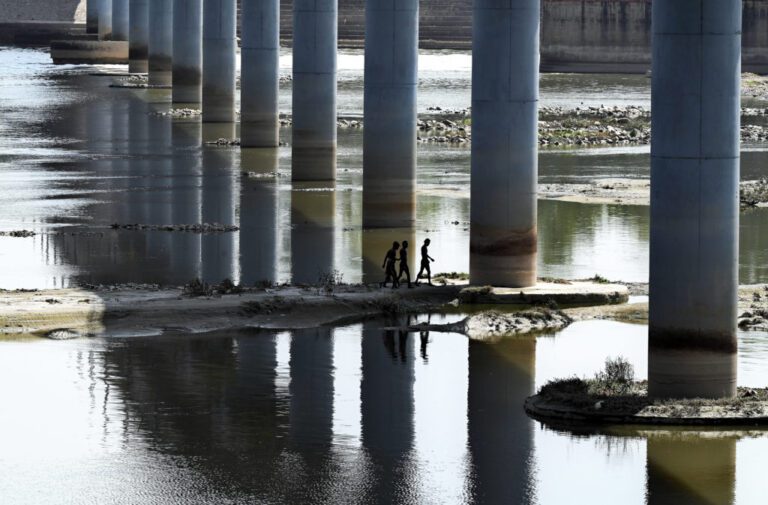People are seen bathing in the water of the Yamuna River on a hot summer day on June 8, 2023 in Noida, Uttar Pradesh, India. Photo by Sunil Ghosh/Hindustan Times via Getty Images
LUCKNOW, India (AP) — At least 96 people have died in two of India's most populous states in recent days, officials said Sunday, as parts of the country grapple with a blistering heat wave.
The deaths occurred in the northern state of Uttar Pradesh and eastern Bihar, where authorities warned residents over 60 and others suffering from various illnesses to stay indoors during the day.
All the fatalities in Uttar Pradesh, a total of 54, were reported in Ballia district, about 300 kilometers (200 miles) southeast of Lucknow, the state capital. Authorities found that most of those who died were over 60 years old and had pre-existing health conditions that may have been exacerbated by the intense heat.
SK Yadav, a medical officer in Ballia, said that in the last three days, around 300 patients were admitted to the district hospital for various ailments aggravated by the heat.
Due to the seriousness of the situation, the authorities canceled applications for medical staff leave in Bali and provided extra hospital beds in the emergency department to accommodate the influx of patients.
Officials said most of the admitted patients are aged 60 and older, presenting with symptoms of high fever, vomiting, diarrhea, breathing difficulties and heart problems.
READ MORE: We don't know exactly how many people die from the heat — here's why
RS Pathak, a resident of Ballia who lost his father on Saturday, said he saw an increased flow of patients in the hospital's emergency department while attending to his father.
“This has never happened in Bali. I have never seen people die because of the heat in such large numbers,” he said. “People are afraid to go out. Streets and markets are largely deserted.”
Ballia, along with central and eastern Uttar Pradesh, is currently grappling with oppressive heat.
On Sunday, the region recorded a maximum temperature of 43 degrees Celsius (109 degrees Fahrenheit), exceeding the normal range by five degrees. Relative humidity was recorded at 25 percent, intensifying the effect of the heat.
Atul Kumar Singh, a scientist with the India Meteorological Department, or IMD, said temperatures across the state were currently above normal. He added that “no relief is expected in the next 24 hours.”
The IMD has issued a warning saying heatwave conditions will continue till June 19 in parts of Uttar Pradesh.
The state's health minister, Brijesh Pathak, said an investigation had been launched into the cause of death of “so many people” in Ballia.
In eastern Bihar, scorching heat has engulfed most of the state, leading to 42 deaths in the past two days. Among the deaths, 35 occurred in two hospitals in the state capital Patna, where more than 200 patients were being treated for diarrhea and vomiting.
Patna recorded a maximum temperature of 44.7 Celsius (113 F) on Saturday.
The main summer months – April, May and June – are generally the hottest in most of India, before the monsoon rains bring cooler temperatures.
But temperatures have become more intense in the last decade. During heat waves, the country typically faces severe water shortages, with tens of millions of its 1.4 billion people without running water.
I'M WATCHING: India's deadly heat wave shows the real effects of climate change
A study by World Weather Attribution, an academic group that looks at the source of extreme heat, found that a blistering heat wave in April that hit parts of South Asia was at least 30 times more likely due to climate change.
In April, the heat killed 13 people at a government event in India's financial capital, Mumbai, and forced some states to close all schools for a week.
Associated Press writer Indrajit Singh in Patna, India contributed to this report.
Left:
People are seen bathing in the water of the Yamuna River on a hot summer day on June 8, 2023 in Noida, Uttar Pradesh, India. Photo by Sunil Ghosh/Hindustan Times via Getty Images



